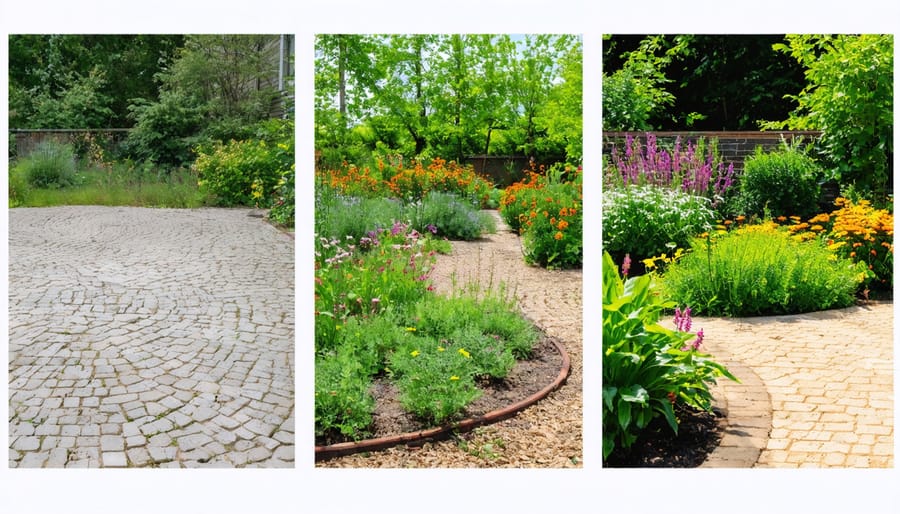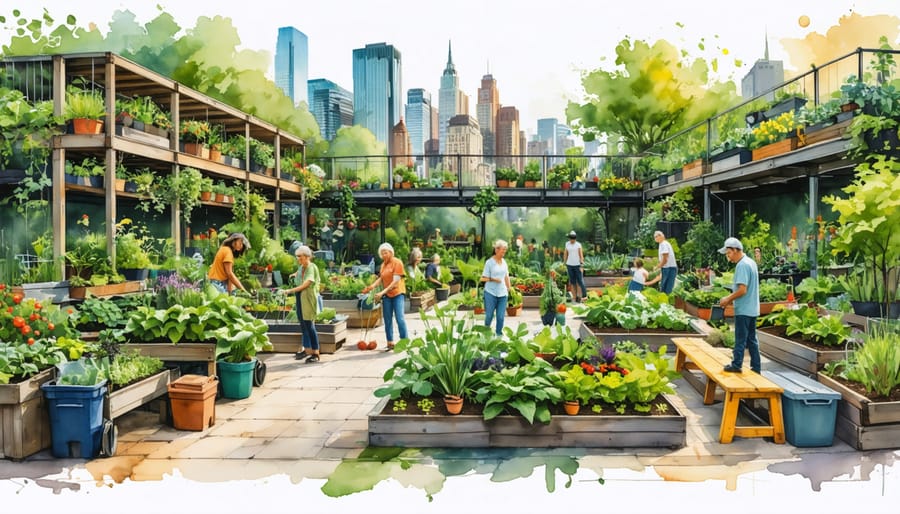In times of uncertainty, gardens emerge as powerful symbols of resilience, offering both sustenance and solace. More than mere plots of earth, these living spaces tell stories of human perseverance, from victory gardens during wartime to modern urban oases thriving in concrete jungles. Today’s garden of resilience represents a deliberate choice to create abundance in the face of challenge, combining time-tested wisdom with innovative sustainable practices.
These sacred spaces do more than grow food—they nurture hope, build community, and demonstrate nature’s remarkable ability to adapt and flourish despite adversity. Whether it’s drought-resistant native plants pushing through harsh soil, vertical gardens maximizing limited urban space, or community plots transforming food deserts into green havens, resilient gardens showcase humanity’s creative spirit and determination to thrive.
As climate change and social upheaval reshape our world, the concept of resilient gardening has evolved from a practical pursuit into a powerful movement. By incorporating diverse plant species, implementing water-wise techniques, and fostering soil health, these gardens become living laboratories of adaptation and regeneration. They remind us that even in the smallest spaces, we can create ecosystems that sustain both people and planet, proving that the simple act of tending a garden can be a profound statement of hope and resistance.
Let your garden become a testament to resilience—a space where challenges transform into opportunities, and every season brings new lessons in adaptation and growth.
The Power of Resilient Gardens
More Than Just Plants
Gardens are more than just collections of plants and flowers; they’re living testimonies to human resilience and community strength. When neighbors come together to transform vacant lots into vibrant community gardens, they create spaces that nourish both body and spirit. These green sanctuaries become meeting grounds where friendships bloom alongside vegetables, and where diverse communities find common ground through shared purpose.
For many, gardens serve as powerful symbols of personal empowerment. Whether it’s a first-time gardener successfully growing their own food or a community healing through collaborative garden projects, these spaces foster independence and self-reliance. Gardens teach us patience, persistence, and the importance of nurturing growth – skills that extend far beyond the garden beds.
In times of challenge, gardens have historically served as beacons of hope. From victory gardens during wartime to modern urban farming initiatives, these spaces demonstrate humanity’s remarkable ability to adapt and thrive. They remind us that even in concrete jungles or during difficult times, we can create pockets of beauty and sustenance that strengthen both individual resolve and community bonds.
Historical Gardens of Hope
Throughout history, gardens have served as powerful symbols of hope and resilience during challenging times. The Victory Gardens of World War II stand as a testament to community strength, where millions of Americans transformed their backyards into productive vegetable plots, providing both food security and emotional comfort. These gardens, which embodied both cultural plant heritage and survival, produced up to 40% of the nation’s vegetables during wartime.
The Jardins Ouvriers (Workers’ Gardens) in France emerged during the Industrial Revolution, offering urban laborers a chance to grow food and find solace in nature. Similarly, the Peace Gardens of Hiroshima, created in the aftermath of devastating destruction, demonstrate how historical garden design can contribute to healing and reconciliation.
More recently, the community gardens of Detroit, born from urban decline, have transformed abandoned lots into thriving green spaces, proving that gardens can spark revival and hope in even the most challenging circumstances. These examples remind us that gardens are more than just pleasant spaces – they’re powerful tools for community resilience and personal renewal.
Creating Your Own Garden of Resilience
Choosing Resilient Plants
Selecting the right plants is fundamental to creating a resilient garden that thrives through various challenges. Native plants often make excellent choices, as they’ve naturally adapted to local conditions over thousands of years. These hardy survivors know how to handle your region’s specific climate, soil type, and weather patterns.
Consider drought-tolerant plants like lavender, yarrow, and Russian sage, which continue to flourish even when water is scarce. Herbs such as rosemary, thyme, and sage not only withstand tough conditions but also provide culinary benefits. For shady areas, try reliable performers like hostas, ferns, and astilbe that persist despite limited sunlight.
Perennials are particularly valuable in a resilient garden because they return year after year, developing stronger root systems over time. Black-eyed Susans, coneflowers, and salvias are excellent examples that offer both durability and beauty. These plants attract pollinators while standing strong against various weather conditions.
When choosing plants, look for those labeled as “disease-resistant” or “pest-resistant.” Modern plant breeding has produced many varieties that maintain their resilience while requiring minimal intervention. Remember to group plants with similar water and sunlight needs together, creating microclimates that support each other’s growth.
Most importantly, observe which plants naturally thrive in your neighborhood. These local survivors often provide the best clues for what will succeed in your own resilient garden.

Sustainable Design Principles
Creating a resilient garden starts with thoughtful design principles that work in harmony with nature. Just as you might create a sacred garden sanctuary, a resilient garden should follow natural patterns and promote ecological balance.
Begin by observing your space’s natural features – sunlight patterns, water flow, and existing vegetation. Work with these elements rather than against them. Incorporate diverse plant layers, from ground covers to tall trees, mimicking forest structures. This vertical layering creates multiple habitats and maximizes space efficiency.
Water management is crucial – design swales and rain gardens to capture and direct rainfall where it’s needed most. Choose permeable pathways that allow water to seep into the soil naturally. Group plants with similar water needs together in hydrozones to optimize irrigation.
Include circular or curved designs rather than straight lines to encourage natural flow and maximize edge spaces where biodiversity thrives. Create plant communities rather than isolated specimens, allowing beneficial relationships to develop between species. Consider implementing keyhole beds or mandala gardens that minimize walking distances and maximize growing space.
Remember to include spaces for pollinators and beneficial insects by incorporating flowering plants throughout the seasons. Add structural elements like rock gardens or log piles that provide shelter for wildlife and create microclimate variations. These features not only enhance biodiversity but also contribute to your garden’s overall resilience and sustainability.
Nurturing Community Connections
A garden’s true magic lies in its ability to bring people together. Transform your resilient garden into a welcoming space where community connections can flourish, much like the plants you tenderly nurture. Start by creating comfortable seating areas using recycled materials like wooden pallets or reclaimed benches, arranging them in conversation-friendly clusters that invite people to gather and share stories.
Consider dedicating a portion of your garden as a living art gallery where neighbors can display their creativity through sculptures, paintings, or collaborative installations. Install a community bulletin board where gardeners can share tips, trade seeds, or organize garden-related events.
Host regular garden-sharing days where neighbors can exchange surplus produce, creating a micro-food network that strengthens community bonds. Set up a children’s corner with simple gardening tools and kid-friendly plants to nurture the next generation of green thumbs. Design wide paths that accommodate wheelchairs and strollers, ensuring everyone feels welcome in your green sanctuary.
Remember to include a shared herb garden where community members can harvest fresh herbs for their cooking – nothing brings people together quite like the love of good food. By creating these thoughtful spaces for connection, your garden becomes more than just a plot of land; it transforms into a living, breathing hub of community resilience and shared growth.

Stories of Garden Resilience
Urban Victory Gardens
Urban victory gardens are experiencing a remarkable revival in modern cities, breathing new life into the historical concept that helped communities through challenging times. Today’s urban gardeners are transforming balconies, rooftops, community plots, and even vertical spaces into productive growing areas that foster both food security and community resilience.
These contemporary victory gardens take many creative forms. Innovative container gardening allows apartment dwellers to grow vegetables in self-watering systems, while shared community plots create opportunities for neighbors to exchange knowledge and resources. Vertical gardening techniques maximize limited space, turning walls and fences into thriving food production zones.
Many urban gardeners are incorporating sustainable practices like composting, rainwater harvesting, and companion planting into their victory gardens. These methods not only reduce environmental impact but also create more resilient growing systems that can withstand urban challenges like limited resources and extreme weather.
The social impact of modern victory gardens extends beyond food production. These spaces serve as community hubs where people share seeds, knowledge, and harvest celebrations. Schools are incorporating educational gardens, teaching children about food sovereignty and environmental stewardship. Local food banks are partnering with victory gardeners to distribute fresh produce to those in need.
By adapting historical victory garden principles to modern urban contexts, these gardens demonstrate how cities can become more self-reliant and sustainable while building stronger community bonds.

Community Garden Transformations
Communities worldwide have demonstrated remarkable resilience by transforming vacant lots and neglected spaces into thriving garden sanctuaries. In Detroit, residents converted abandoned properties into productive urban farms, not only providing fresh produce but also creating spaces for neighborhood connection and healing. These gardens now feed hundreds of families while serving as outdoor classrooms for local schools.
In the wake of natural disasters, community gardens have played crucial roles in recovery efforts. After Hurricane Sandy, New York City residents rebuilt destroyed community gardens, incorporating flood-resistant design elements and native plants that could withstand future storms. These spaces became symbols of hope and renewal, bringing together residents who might otherwise have left the area.
In food desert areas, community gardens have become vital sources of fresh produce and nutrition education. The Grow Together initiative in Atlanta transformed an unused parking lot into a vibrant garden that now supplies fresh vegetables to local food banks and teaches residents about sustainable growing practices. Senior citizens mentor younger generations, sharing traditional growing methods and creating lasting connections across age groups.
These transformative gardens do more than grow food – they cultivate community bonds, provide therapeutic spaces for healing, and demonstrate the power of collective action. From memorial gardens honoring lost loved ones to victory gardens during times of crisis, these green spaces prove that when communities come together to nurture the earth, they nurture themselves in the process.
Personal Stories of Growth
Maria Thompson, a retired teacher from Oregon, found solace in her garden after losing her husband. “Every seed I planted became a promise of tomorrow,” she shares. “When my tomatoes survived a harsh frost, it reminded me that I too could weather any storm.” Through careful nurturing and patience, Maria transformed her backyard into a thriving sanctuary that helped her heal and grow.
James Chen, an urban gardener in Chicago, turned a vacant lot into a community garden after losing his job during the economic downturn. “Starting with just a few raised beds, we now feed dozens of families,” he beams. “The garden taught me that setbacks are just setups for comebacks.” His initiative not only provided fresh produce but also built lasting connections among neighbors.
Sarah Martinez, dealing with anxiety, discovered peace in her herb garden. “Tending to my plants grounds me in the present moment,” she explains. “When my lavender bounced back after nearly dying, it showed me that resilience isn’t about avoiding failure – it’s about how we recover and adapt.”
These stories highlight how gardens become more than just spaces for growing plants; they’re living metaphors for personal growth and renewal. Each gardener’s journey reflects the universal truth that, like plants, humans have an innate capacity to flourish even after difficult seasons.
As we cultivate our gardens of resilience, we nurture more than just plants – we cultivate hope, strength, and community. These living spaces have proven time and again to be powerful sources of healing and renewal, offering sanctuary during challenging times and celebrating life’s persistent beauty. From victory gardens of wartime to modern community plots in urban food deserts, gardens continue to demonstrate humanity’s remarkable capacity to adapt and thrive.
Today’s gardeners are carrying forward this legacy of resilience, creating spaces that not only produce food and beauty but also serve as living laboratories for sustainable practices and climate adaptation. Each seed planted is an act of faith in the future, each harvest a testament to nature’s abundance and our role as stewards of the earth.
Looking ahead, gardens will become increasingly vital as we face environmental challenges and seek connections in an increasingly digital world. They remind us that even in concrete jungles, nature finds a way to flourish. Whether you tend a windowsill of herbs, a backyard vegetable patch, or a community garden plot, you’re participating in an ancient and ongoing story of human resilience.
Remember that your garden, no matter its size, contributes to a larger tapestry of hope and renewal. It’s a living reminder that with patience, care, and determination, we can create beautiful and productive spaces that nourish both body and soul. As you continue your gardening journey, take pride in knowing that you’re not just growing plants – you’re cultivating resilience for generations to come.




